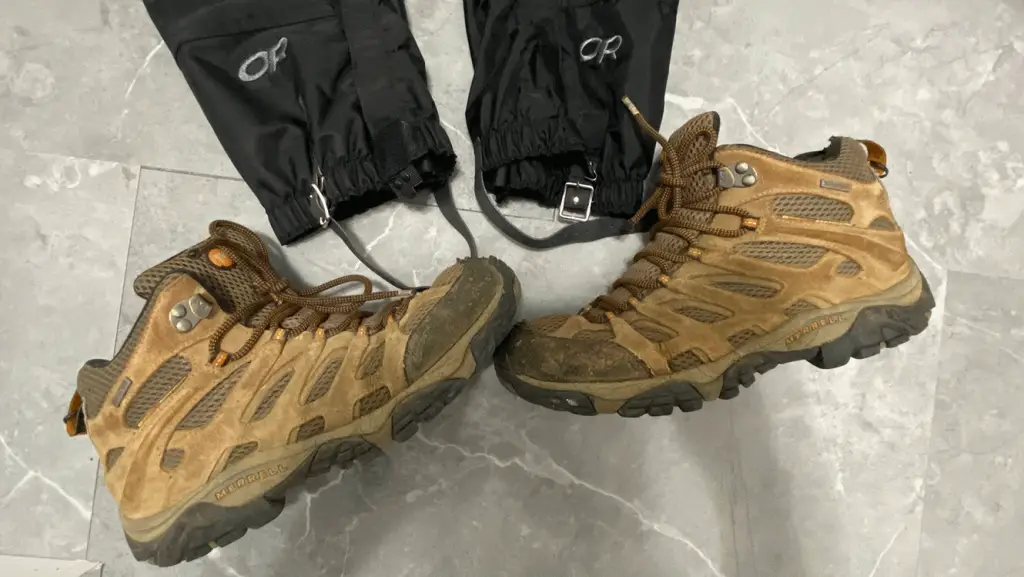Hiking trails take you to wonderful views and vistas. You have your hiking pack, hiking clothes, and nice hiking shoes, however the trail also takes small rocks and gravel into your shoes. This can be really annoying as the rocks can rub against your feet and cause discomfort. What can you do to keep rocks out of your hiking shoes?
You can keep rocks out of your hiking shoes by covering them with gaiters. Gaiters will help block rocks, gravel, bugs, light rain, and even snow from entering your shoes on your next hike.
Before I realized hiking gaiters existed, I always had small rocks go into my shoes during my hikes. It really is a hassle to stop and pull the rock out. Sometimes rocks would even get into my socks! You might be eager to go out and buy any gaiter to stop rocks from entering your hiking shoes, but there are some things you should consider before you buy them. We will go over the pros and cons down below
What Are Gaiters (Pros and Cons)

Gaiters are a foot covering designed to prevent trail debris from entering your shoes. There are many different types of gaiters. Some will keep water and snow out and some will only keep rocks out. Gaiters will help prevent those annoying rocks from going into your hiking shoes and socks.
Gaiters get wrapped around your lower leg and cover your ankle and the top of your shoes. This will completely block things from entering your shoes. While gaiters will prevent rocks from enter your shoes there are things to think about.
Pros of Gaiters
The main benefits of gaiters are that they will stop rocks and other debris from going into your shoes. Since they are a small material, they are typically lightweight and pack down easily. Gaiters are easy to use and get the job done well.
There are a few different types of gaiters designed for common outdoor scenarios. There are general hiking gaiters, gaiters for mountaineering, and gaiters for trail running. Depending on which activity you choose you can pick more heavy duty gaiters that completely block all debris and the elements out of your shoes. You can protect your shoes for a variety of scenarios with gaiters.
Cons of Gaiters
The main con of gaiters for hiking is having to put them on. It would be nice to be able to hike and not worry about having rocks enter your shoes and have to carry gaiters. Gaiters wrap around your shoes and lower leg. Some gaiters can feel uncomfortable because of the straps tightening against your ankle or lower leg.
Another minor con of gaiters is that you have to pack something extra which takes up space in your pack. For you trail minimalists this is not ideal. However this minor weight is forgotten as you will be able to hike without thinking about rocks entering your shoes during the entirety of your hike.
Best Outdoor Research Gaiters on Amazon
Altra Lightweight Trail Gaiters on Amazon
What to look for in Gaiters

Material
One of the most important things to look for in gaiters is the material it is made of. If you are trail running then most of the gaiters are lightweight and made of a thin stretchable polyester. These are only designed to keep debris from entering your shoes. The normal hiking gaiters are much thicker and will wick water away. Finally the mountaineering gaiters are the thickest and are designed to keep rocks and snow out of your boots.
The thinner the material the more breathable and the more heavy duty the less breathable it is. These are the tradeoffs you should consider when picking your gaiters. Since the hiking and mountaineering gaiters are thicker they are going to be more durable. I like to mostly use the trail running gaiters because my goal is to prevent rocks from entering. If there is any rain then I have my long rain pants.
Height
The next thing to think about is the height of the gaiter. Gaiter heights vary from only going as high as your ankle, up halfway your shin and all the way up to your knees. The longer the gaiter the more leg protection you have. The longer gaiters attach to your leg via straps, so you can loosen and tighten them to your comfort.
The ankle height gaiters are designed to keep small debris out of your shoes. The shin height gaiters are designed to prevent rocks from entering and a bit of rain. The knee high gaiters are typically used if you expect to encounter deep snow. Each height will help you with a different scenario, most people will typically only use the ankle height gaiters for a majority of their hikes.
Waterproof
Depending on the type of environment you are hiking in, the last thing to look into is if the gaiters are waterproof. If you typically hike in a rainy area or expecting rain on your next hike then consider looking into waterproof gaiters. Waterproof gaiters will prevent rain from entering the top of your hiking shoes. They cover your ankles and the top of your shoes which will make the water roll off your shoes as you are hiking.
The tradeoff with waterproof gaiters is that they are not breathable. This can lead to your feet becoming hotter and sweaty due to lack of airflow at the top of your shoes. Waterproof gaiters combined with waterproof hiking shoes are a great way to ensure your feet stay dry.
Best Outdoor Research Gaiters on Amazon
Altra Lightweight Trail Gaiters on Amazon
Alternatives to Gaiters
>
Long Hiking Pants
Now that we have gone over the pros and cons of gaiters and the main things to look out for, there are some things you might already have that you can use as an alternative. The first alternative is to use long hiking pants. Long hiking pants can be wrapped around your hiking shoes and prevent a majority of debris from entering your shoes.
There are even some long hiking pants that have a strap or extra flap of material that act like a gaiter that you can wrap around your ankle. This is really convenient because then you don’t have to remember to pack gaiters as they are built into the pants. The downside of this is that if you don’t need the gaiter flap then your ankle can get very warm. Long hiking pants can do a good enough job from blocking rocks from entering, but there are the occasional rocks that can sneak by, so this isn’t a perfect solution.
Columbia Hiking Pants with Gaiters on Amazon
Mindful Walking
If you don’t want to buy any new gear then an alternative is to practice mindful walking. You can prevent rocks from entering your shoes by carefully walking as you hike. In very rocky and gravel heavy areas you can walk a bit slower and try not to get rocks into your shoes.
DIY Sock Gaiters
A DIY alternative to gaiters is to use old socks. You can cut off the elastic band on the opening of the sock off and the area of the toes to create an elastic rectangle of fabric. Then you can wrap the material around the top of your shoe and over your ankles. This will do the same job as gaiters and block rocks from entering your shoes.
The downside to these DIY sock gaiters is that they will not be as durable and not waterproof. This is a nice quick way to test out the idea of gaiters. You should only use these for hiking on trails where there is no rain or snow.
Final Thoughts
Heading out to a hike to hike in the serene forest and catch a moment of the sun setting on the sweeping vistas can be completely ruined when you take a step and there is a small rock in your shoes. Getting a pair of gaiters can help you by blocking all debris and rocks from going into your shoes. You will never have to think about rocks from entering your shoes ever again.
Alongside blocking rocks from entering your shoes, you now also know there are gaiters that can block rain water and snow. Trying out various gaiters is a lot of fun as you are walking around and finally realizing you don’t need to think about rocks getting into your shoes. Enjoy your next rock free hike!
